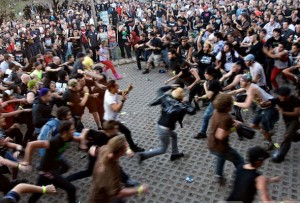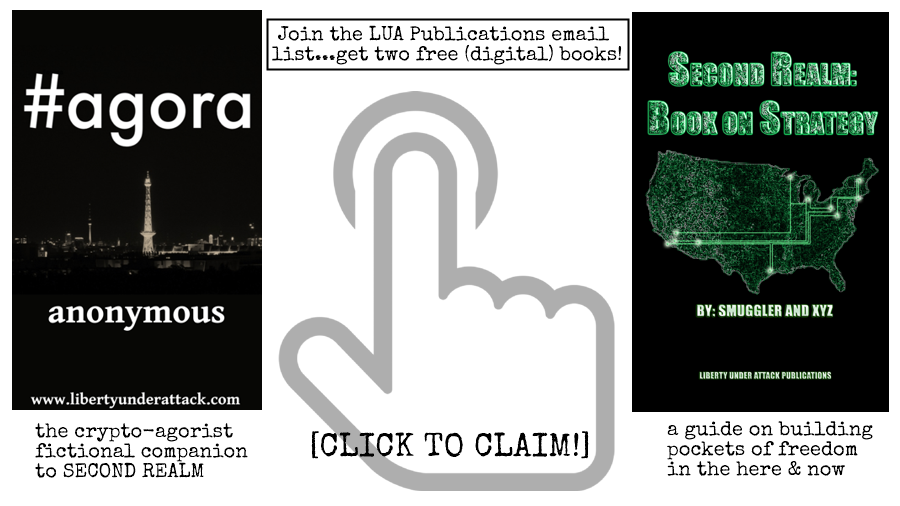Consensual Violence: Spontaneous Order in a Mosh Pit
This article is being republished from FEE, under the auspices of Creative Commons. All credit goes to Mike Reid and FEE.
Editor’s note: Being a metal head, I saw the importance of this article, in explaining the spontaneous order of the market, by way of the spontaneous order within mosh pits at metal shows.
By: Mike Reid
January 5th, 2016
 I was violently attacked by a muscle-bound youth. But he committed no aggression against me.
I was violently attacked by a muscle-bound youth. But he committed no aggression against me.
With a big grin, the young man shoved me hard through the crowd. I staggered, wheeling backward on my heels for a few futile steps before falling flat on my back on the concrete floor. My glasses bounced off my head and skittered into the forest of stomping feet behind me. I flailed over my head for them with my arm, but then the guy who’d pushed me jumped right on top of me.
I was not angry at my assailant. I had asked for his attack just by being there, in the mosh pit.
This was my first mosh pit, and my first heavy-metal concert. (The band was Iced Earth, by the way, and its main songwriter has a G. Edward Griffin–inspired quasi-libertarian side project called Sons of Liberty.)
Much of what I saw at the concert wasn’t surprising: the huge urban barbarian in a chain-mail shirt; the skinny teen boy with hair that hadn’t been cut since he was in diapers; and the four-and-a-half-foot-tall, 80-pound girl in a torn Slayer shirt. I knew those characters would be there.
I also knew there’d be a mosh pit, with great big guys and skinny little guys and 80-pound girls shoving and smashing into each other right up close to the stage.
As I got closer to the mosh pit — song after song, I’d edge my way toward it, seeing if maybe I could get a taste of what it was like before joining in wholesale — I realized that it worked as a spontaneous space that allowed for some low-level violence (shoving and elbowing and so on) without aggression. That’s when I jumped in.
Context Is Everything
Aggression, as I understand the term, involves an uninvited invasion or use of force against person or property. To be aggression, it has to be nonconsensual.
For instance, if I use a coat hanger to bypass the lock on your car door, that might be aggression. But what if you had locked your keys inside, and you asked me to help you get them out?
If I kiss you, it’s definitely aggression if you have just forbidden me to do so. It’s probably not if the wedding officiant has just told me, “You may kiss the bride.”
So you cannot usually tell aggression from consensual behavior by looking at just a snapshot of physical action. You need to see the context of the interactions and know the intentions of the participants.
It’s even possible to have consensual, nonaggressive violence, as in a boxing match — or a mosh pit.
By joining the mosh pit, you invite — you consent to — a certain amount of pushing and shoving.
Fluid Boundaries
But what about the boundaries of the mosh pit, and the other people attending the show? The “pit” itself is amorphous. There is no official or architectural border, and the pit grows and shrinks as the number and enthusiasm of the moshers waxes and wanes.
Furthermore, people like me are constantly tumbling out of the pit, and there are innocent, non-moshing bystanders nearby, dancing and recording videos and generally doing things that shouldn’t be interrupted by tumbling men who’ve lost their glasses.
In this sense, some uninvited “invasion” clearly does occur, and certainly some moshers do get out of hand, both within the pit and beyond it. But there is a spontaneous institution that helps to keep this aggression toward non-moshers in check. I’ll call them the single-pleasure pushers.
Pleasures of the Pit
There seem to be at least two pleasures of the pit: the release of energy and anger by pushing someone else, and the release of control over your own body when you are pushed.
Now, some moshers don’t like both these pleasures equally. I was ready to be pushed around, but I didn’t trust myself to be a pusher: I was worried that in my inexperience I’d either hurt somebody by pushing too hard or embarrass myself by nudging too gently.
Then there are other people who enjoy pushing but don’t want to be pushed. What do they do? They stand around the back edge of the mosh pit in a semicircle, watching both the pit and the show on stage. And when people inside the mosh pit proper spill out toward the main concert area, these single-pleasure pushers joyously shove them back in.
It doesn’t always work (as my own inexpert stumble and fall into the surrounding crowd demonstrates), but it certainly does limit the amount of interference that the moshers impose on the non-moshers.
In this way, single-pleasure pushers allow full-blown double-pleasure moshers and single-pleasure pushees to exert themselves energetically and even violently without imposing excessive interference on surrounding non-moshers (dancers, video-takers, etc.).
Spontaneous Order and Commercial Success
There was no official organization of this system for maintaining a flexible boundary between the realm of consensual violence in the mosh pit and the ordinary zone of the rest of the concert. There were no state laws assigning quotas for pushing-only duty, nor laws defining how big or small a mosh pit could be.
There were no special badges to indicate who would play what role (which would, after all, have made it more difficult for people to switch roles as the mood struck them). There was no official doctrine that anyone had to explain to anyone else. Instead, the whole raucous affair was governed by a spontaneous order of human desires.
Because this all occurred in the context of a private entertainment enterprise, both the concert venue and the musicians had an incentive to find the right balance for their customers. They wanted fans to come for the unique, in-the-flesh experience of the concert rather than to sit at home and listen to the same music on their iPhones, or to wait to watch the whole thing the next day on YouTube.
If moshing became too dangerous for the fans, or began to interfere too much with the enjoyment of the non-moshers, the bands and businesses involved would lose revenue from the timid. If the moshing became too tame, they would lose revenue from the energetic.
Perhaps different bands strike different balances, based on their own niches of the heavy-metal market. The opening act, Warbringer, with a theatrical style suited to their name, encouraged the mosh pit to grow to a brutal ferocity and prodigious size until it took over nearly the whole dance floor. Presumably, they thought this environment served their loyal fans in the market (who were notably younger and more predominantly male than the general crowd).
In short, everyone involved had their own incentives, based on their own desires, to keep one another safe from aggression, exposed to the level of violence they desired, and generally entertained.
When that big guy jumped on top of me, I flinched and closed my eyes for a moment in anticipation of the worst. Then I realized I wasn’t being pummeled, and I heard him shout, “I got you, bro!”
And when I opened my eyes, he held my glasses out, having rescued them from the dancing feet around us.



Trackbacks/Pingbacks